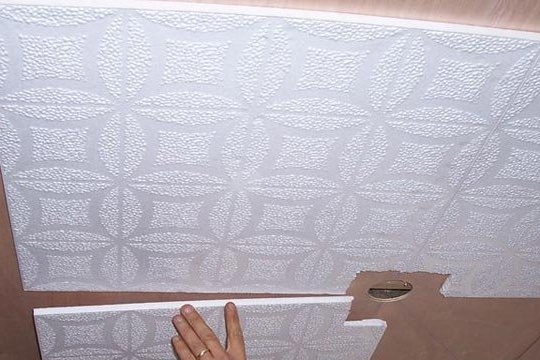Ceiling ceiling finishing is the final chord in creating the interior of an apartment and office. In this article we will talk about such a facing material as adhesive ceilings, considering their advantages and disadvantages. The adhesive ceiling is made of polystyrene tiles having a square or rectangular shape.
Polystyrene, which is more commonly known as polystyrene, provides lightness to the ceiling surface, which allows gluing the panels to the base of the ceiling with little effort using special glue, as well as PVA or liquid nails. In this case, the base of the surface can be any. So, it is allowed to mount polystyrene plates on a concrete and wooden surface, on brickwork, plaster coating, as well as gypsum and chipboard. The traditional sizes of polystyrene polystyrene tiles (50x50 cm and 100x16.5 cm) make it possible to choose the most optimal option for your room. Whereas the decorativeness of the plates is ensured by additional
decorative finishes. There are plates, the relief texture of which completely repeats the relief of stucco molding and woodcarving. Thus, in accordance with your interior, you can choose a ceiling that simulates the lining of stone or fabric. It should be noted that among polystyrene plates they can be laminated, that is, they can withstand conditions of high humidity. But unprocessed slabs provide for mandatory subsequent staining. Using water-based paint, you can achieve the perfect color effect
the ceiling.
Ceiling tiles are divided into three groups:
1. Stamped - made from thin strips that are cut from polystyrene blocks intended for construction;
2. Injection - is made directly from polystyrene foam raw materials, which are “baked” in special molds of a molding and molding machine;
3. Extruded - made of painted or coated with a thin film extruded polystyrene.
Taking into account the correctness of the forms, injection tiles have the best quality characteristics, due to the high precision of the production technology. But the extruded panels at the exit already have a decorative finish or color. Often, to obtain a more refined and solid ceiling, the panels are complemented by specially selected skirting boards,
shaped profiles, attractive decorative stucco made of polyurethane.
Advantages of adhesive ceilings:
- ease of installation;
- ease of construction;
- the ability to hide under the plates small defects in the ceiling surface;
- the ability to replace damaged tiles with a whole;
- soundproofing properties;
- fire resistance of the material;
- ease of processing (panels are easily cut with a wallpaper knife).
Disadvantages:
- the complexity of the preparatory work;
- the presence of seams and joints between the plates interfere holistically perceive the ceiling;
- a tendency to change color under the influence of ultraviolet rays (the ceiling turns yellow);
- instability of non-laminated boards to dampness;
- under the influence of thermal localized radiation, the polystyrene ceiling can melt;
- the impossibility of installing such built-in ceiling structures as lamps, ventilation systems, alarm systems, etc.
Rules for caring for glue ceiling:
- non-laminated panels must be regularly cleaned with a dry cloth and vacuum cleaned using a soft nozzle;
- it is enough to wash the laminated plates with a damp sponge using a soap solution, while it is advisable not to fill the strips themselves with water.

